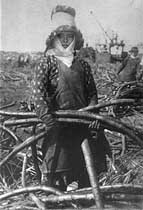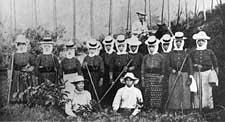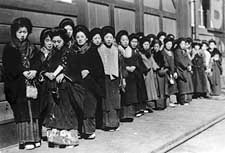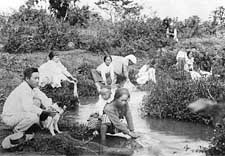 Head-to-toe clothing protected workers against hot sun and field hazards, ca. 1912 |
During the "Picture Bride Period," which bridged the years between 1908 and 1924, a mass influx of immigrant brides transformed Hawai'i's plantation society. Once predominated by single male transients, the plantations began to include permanent residents with families.
Within this span of time, more than 20,000 picture brides came to Hawai'i to marry immigrant plantation laborers. Most of the women came from Japan, with a smaller number travelling from Korea.
![]()
![]()

![]()
Head-to-toe clothing protected workers against hot sun and field hazards, ca. 1912
The marriages between the Japanese men and women were arranged by a nakodo (go-between), who negotiated with the parents of the prospective bride and groom by exchanging letters and photographs. These women, who came from the main islands of Japan and Okinawa, brought with them to this strange land familiar pieces of clothing, including intricately handwoven kasuri, silk kimono and obi (sashes).
These picture brides came for many reasons: Some were forced into arranged marriages with men they had never met: some were attracted by the promise of adventure; some were eager to escape the drudgery of farm work. Instead of finding the paradise they had heard so much about, many were disappointed and disillusioned when they first met their husbands at the immigration station at Honolulu Harbor. Some of the grooms were fifteen or twenty years older than the brides, and in many situations, they did not resemble the pictures sent by the nakodo. Some men sent photos of their friends who were younger and better-looking.
One bride was devastated when her husband took her to a desolate-looking home in Waiakea. The walls were made of rough lumber and the whitewash paint constantly fell on the floor. She didn't think it was fit for human beings to live in. Her husband had sent her a photo of himself, standing proudly in front of an elegant white mansion where his friend worked as a yardman.
Not all the picture brides were met by their grooms. At the immigration station, one issei woman found herself an unclaimed bride. She waited for two weeks for her husband to come; he never did. She cried every day as she watched brides who had made the same voyage leave with their husbands. She did not have any money to pay for passage back to Japan. Dr. Tomizo Katsunuma, the immigration inspector, sympathized with her, took her home, and provided lodging. Later, he played the role of matchmaker and found her a good husband. She was forever grateful to him.
 Japanese cane workers, with luna on horseback |
At first the issei men and women wore as work clothes the kasuri, or sturdy, striped cotton kimono they had brought with them, or they put together makeshift work outfits. Men wore their momohiki (fitted pants) and shirts with long, narrow sleeves, underneath their cotton kimono. But they soon realized that the kimono was too cumbersome and ill-suited for work in the fields.
The issei men readily accepted the standard work clothing worn by men of other ethnic groups who were plantation laborers. As long as the garment was affordable, comfortable and served its purpose, they were satisfied. From the Portuguese, Spanish and Filipino workers, they adopted the wide variety of straw hats, and the bright red and blue bandanas.
For formal occasions, no matter how poor he might be, the issei male invested in a dark wool suit early in his settling-down period. The suit cost about $20, an entire month's pay. To make the payment, some men formed a tanomoshi (a mutual financing system). This one dark suit lasted a lifetime and was worn for special occasions such as weddings, funerals, community functions, and sometimes for the final journey into the next world.
 Japanese immigrant women at dockside |
The kasuri kimono brought from Japan were taken apart and made into Chinese-style jackets with kimono sleeves and mandarin collar. They learned to fashion their pleated or gathered skirts out of American cotton fabrics. It proved far more practical and economical than using the twelve-inch wide, handwoven kasuri fabric brought from the village.
A wide cummerbund-like sash held their work outfit together. This sash was the counterpart of the obi sash worn with the kimono and like it had a symbolic significance for the issei women. They liked the comfort and security of the wide black sash around their waist. Some of them even said it gave them the strength to endure the ten hours of hard work on the plantation. And often, when they were hungry, the tightness of the sash helped them to overcome the pangs of hunger.
In many of the early pictures of issei women, a dollar pocket watch was carefully tucked into the wide sashes, with the chain left on the outside to give a decorative touch. The picture brides were oshare (fancy dressers) even if they came from farming villages. Men kept their dollar watches in a "watch pocket" that was sewn under the waistband of their trousers. The watch was something of a status symbol, since one dollar in the early 1900s seemed like a fortune to the poor laborers.
 After long days in the fields, women faced laundry and other duties |
She was the one who sacrificed evening or weekend hours, sewing under the dim light of the kerosene lamp. The kappa that became famous throughout the plantation towns in Hawai'i was created through the genius of Zempan Arakawa. In 1904, he came from Okinawa to work for O'ahu Sugar Company in Waipahu. While working in the fields, he realized that the issei workers needed functional and sturdy work clothing and accessories. He pioneered the mass production of kappa and other work accessories, and sold them at an affordable price to the laborers. The wise and frugal issei women bought the kappa from Mr. Arakawa, traced the pattern on old newspapers and started sewing for others to earn extra money.
Besides protecting people from the rain, the kappa had many other uses. In the early 1900s, the issei mothers worked until the last days of pregnancy to earn the twenty-sixth day pay of fifteen dollars with a bonus of one dollar. The midwife walked a few miles to the canefields to deliver a baby, and if it was too far, she rode a horse or a mule. To deliver the baby in the fields, she dug a large hole in one of the furrows in the ground, then placed the kappa in it, oiled side down, to serve as a receptacle to bathe the newborn infant. Fellow workers pitched in to start a fire with dry twigs and dry cane leaves to boil water in a five-gallon can borrowed from the water boy. Mothers who brought their babies to work would share their diapers - made from old cotton yukata or from bleached rice bags - with the new mother.
The women's adjustment to life in the new land differed from those of the men. Men worked hard in the fields all day, but once they came home, they had the luxury of soaking in a hot tub to relax and a warm supper. For the issei mothers, their work and responsibilities were endless even after ten hours in the fields. The issei women had the strength of character which enabled them to face tremendous adversities; many continued to practice their Buddhist faith in Hawai'i. In the Picture Bride film, the young bride is seen praying in front of a Buddhist altar which her husband had bought to help her overcome the loneliness and hardships.
The issei men in palaka shirts and the issei women dressed in kasuri work outfits have disappeared from the plantation landscape, but their stories are preserved in valuable oral histories, books and films for later generations. These men and women weathered disappointment and difficulties to establish their families in numerous communities throughout the islands. They persevered through long hours of hard work, earning very low wages to help support their families in Japan. They sacrificed the little they had for the sake of their children. Their inner strength, innovation and adaptability helped them to endure. That is why despite the hardships and work-worn hands, issei women who came with an adventurous spirit to marry plantation laborers they had never met can still say, "Lucky come Hawai'i!"
A Personal Discovery of Heritage
In conducting the research for my book, Japanese Immigrant Clothing in Hawaii, 1885-1941, I began an exciting journey that has helped me to understand not only the clothing of the issei, but also their struggle to survive and the relationship between Meiji-era village traditions and an emerging plantation culture. This journey has provided me a continuity with my heritage, as it led me on a spiritual voyage back to my parents' native land and my birthplace.
What started as a senior class project in Fashion Design and Merchandising (now Textile and Clothing) at the University of Hawai'i in 1979 has become my lifelong work in the study of Japanese immigrant clothing in Hawai'i. I documented the clothing that was worn from 1885 until 1941, when the Japanese people gradually discarded their traditional customs and clothing with the outbreak of World War II. The majority of the women whom I interviewed for my book had come as picture brides from various prefectures in Japan. As they described their clothing, they also revealed an important part of plantation life and history.
Over the years I have learned to put my own cultural heritage and the childhood experience of growing up on a sugar plantation into perspective. Through my study of clothing I have learned that although the language of another country may be difficult to learn, the outward symbols of clothing are easily transmitted from one culture to another.
Barbara Kawakami is the author of the award-winning book Japanese Immigrant Clothing in Hawaii, 1885-1941. She was a key historian and consultant for the PICTURE BRIDE film, and her collections of photographs, furnishings, and traditional Japanese clothing served as invaluable resources in the development and production of the film.